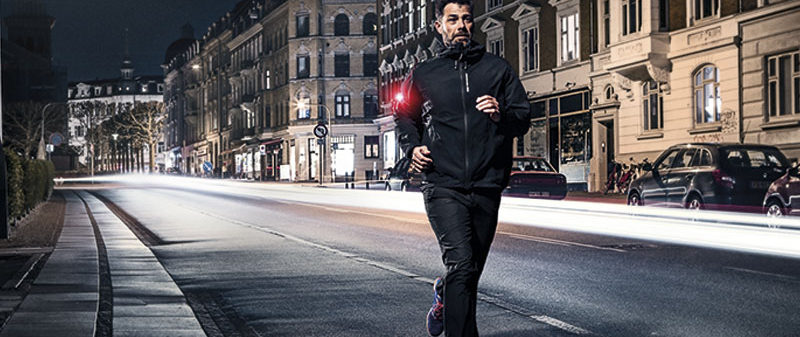We’ve all been there – the calendar is saying winter, just as you have gotten in your best shape. But even though autumn and winter is approaching, there is no reason not to hang on to those great routines, and keep running. Cause who can go without the familiar ‘runners high’ and those tired legs for that many months?
For so many people, autumn and winter means that it will be dark when work is over, and it is time for a run. Even though it may not be pitch black when you go out on your usual route, the darkness can come sneaking up on you. A Norwegian study shows that a car going 50 km/h / 30 miles/h will be able to see a pedestrian dressed in dark clothes from a distance of 30 meters / 100 feet. This will give the driver only two seconds to react. Therefore, it is important to be well prepared, and take responsibility for both the safety of you and others. When you’ve got safety covered you can venture out on the dark roads with ease, and stay in shape all year round.
1. Remember to wear a light
When you are wearing a safety light, you will be able to focus on your run and technique, instead of constantly looking over your shoulder, and wondering if the drivers are attentive of your presence.
Safety lights increase the distance from which a driver can see a runner or other vulnerable road user. This distance could mean the difference of life or death, as visibility from a greater distance will give the driver a longer reaction time, and thereby longer time to react properly and avoid a crash.
With a high-quality safety light you will be seen from a far, and thereby give the driver a longer time to react, evaluate your distance and whereabouts, and finally break or steer clear of you.
2. Combine your lights with reflectors
Reflectors are a great supplement to safety lights, as they signal that you are a vulnerable road user to the driver. There are many colours and kinds of reflectors, so be aware to purchase those which are approved in your country. Furthermore, it is important to be aware of the fact that reflectors fade considerably after washing them continuously. It is therefore necessary to replace your reflectors when they have faded.
The placement of reflectors can have great impact on when the driver is made aware of your presence. The best place to put the reflectors are in knee height or lower, as this is where the drivers front lights hits first.
3. Run without music
Even though the cool beats coming out of your headset might seem indispensable during your run, it might be a good idea to leave the music at home. Having music in your ears can make you inattentive in traffic, and could prevent you from hearing and thereby reacting to danger signals coming from emergency vehicles, signal bells, bulb horns etc. If you MUST run with music in your ears, it is important that you stop and place yourself out of harms way when fx. changing a song. Also, you should keep the volume to a minimum, in order to be able to hear sirens or other danger signals.
4. Run in the correct side of the road
You should always run on the sidewalk or in other paths designated to pedestrians. If it is not possible to run anywhere else than on the road or cycle lane, you should run towards the traffic. This way you will have the ability to spot oncoming traffic, instead of being surprised or caught off guard when they are coming from behind you. If you are running in the cycle lane or on the road, it is important that you keep to the outer edge of the lane, in order for cyclists or drivers to be able to pass you with ease.
If you are running in a crowd, you should if possible use the sidewalk. If you and your group are not able to run on the sidewalk, you should wear a white or yellow light in the front, and a red light in the back, in order to mark the start and end of the crowd when running on the road.
5. Have a plan
Always tell your partner, parent, friend, roommate etc. which route you are planning to run, and when you expect to return from your run. This way there is always someone who can react if you are not back at the agreed time. There are also quite a lot of ‘tracker apps’ that allows you to share your route and location with loved ones. You should always bring your mobile phone on your runs, so that you are able to call for help in case of an emergency or injury.
These tips have been made in collaboration with the Danish running community RunnersDK.
Share this: #orbiloc #orbilocsafetylight
 English
English Deutsch
Deutsch Dansk
Dansk
